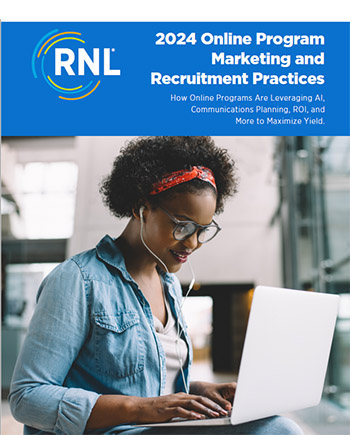graduate & online enrollment
Five Things Online Programs Are Doing Better Than Ever

This week, RNL will release its third report focused on how institutions are currently marketing and recruiting for their online programs. The 2024 Online Program Marketing and Recruitment Practices report focuses specific attention on how online programs are leveraging AI, communications planning, and ROI in addition to question sets on the how and why of marketing and recruitment strategies and tactics.
More than 245 institutional marketing and recruitment leaders from 214 institutions participated in this year’s study and the findings were especially pleasing to me—as the primary researcher of each of these reports over the last six years. Why? Because they reflect a greater share of “best practice” than any of our previous reports. What is my “measure” for a best practice? Primarily it is the extent to which a given practice aligns with the expectations and preferences of today’s students as documented in our student-focused research, while always keeping an eye on efficiency and return on investment.
What did we find to be among the best things online programs are doing? Here are just five among more than a dozen things that reflect incredible progress and excellence:
1. AI: What they are doing
All but 10 percent of institutions are implementing AI solutions in either or both their marketing and recruitment operations. Current initiatives are most frequently focused on marketing content creation (43%) and AI-chatbot/digital assistant deployment (40%), while the most common next steps over the next 12 months are setting up predictive modeling/analytics (31%), leveraging AI for centralized data analysis (30%), and creating an AI-driven student and parent information resource (29%).
2. AI: Why they are doing it
Leaders are embracing AI to better meet the expectations of their students (an essential ingredient in enrollment growth in an era of ever-expanding online program options). They indicate that their goals for AI include improving the student journey from first contact to enrollment (65%), better respond to student expectations for personalized contact and content (58%) and for timely response (51%). While being motivated by improving the student experience, their AI initiatives are improving their efficiency with the greatest share (53%) indicating that AI is already freeing up staff time to focus on high touch activities and streamlining routine tasks (48%).
3. Recruitment processes that get results
Our 2024 Online Student Recruitment Report make clear that students expect prompt, personalized, and regular communication, and when they do not get that, they penalize institutions. Online recruitment operations are getting the message, by assigning early contact to recruiters rather than program staff or faculty (93%), sending a personalized email instead of an automated email as their first step (68%), and doing so within the same business day (52%) with another 37 percent indicating that they respond within 24 hours (albeit often on the next day).
4. Communications flows that work
The strategies that online leaders indicate are getting the best results in retaining prospective students in the enrollment funnel are nearly perfectly in line with what online students told us this past spring. They are doing regular communication through multiple channels (90%), focusing communication on timely reminders of important deadlines and requirements (68%), and providing useful information like financial aid information and assistance (48). We asked them about a wide variety of strategies and proved that these straightforward (albeit not easy) strategies were far more effective than complicated initiatives like offering micro-credentials prior to enrollment (10%), creating peer mentorship programs (8%), or providing early access to course materials (5%). These may be “nice to have” options, but students do not indicate any preference for them.
5. Marketing that aligns with student search patterns
More than 40 percent of online students told us this past spring that they begin their search on a search engine, and another 50 percent indicated that it was their second step. More online marketers than ever before told us that they are regularly attending to program-level SEO with nearly 30 percent indicating that they have done this within that last 30 days and nearly 20 percent more having done so within the last three months. With nearly constant changes and updates to the algorithms on the primary search engine, this is essential to ensuring that prospective students find your programs. Online marketers also told us that they are spending less of their budget on organic search optimization (17%) than the proportion of their highest quality of leads (35%).
Read the full report for more findings on online program marketing and recruitment practices
As you work through the report, consider creating a scorecard for each of the 31 findings to determine where you are in relation to your peers. If you are within five percentage points of the leading responses, you are in a pretty good position to compete with peer institutions with online programs. If not, you will know where your primary areas of focus need to be over the next year.
If you’d like to discuss the findings with an RNL enrollment consultant, reach out to set up a time to talk with one of our experts.
Read the 2024 Online Program Marketing and Recruitment Practices Report

What works with online program marketing and recruitment? Which strategies are the most effective and have the greatest ROI?
Find out in our survey of more than 200 enrollment professionals. Download our free report to dive into more than 30 findings across four key areas:
- Incorporating AI into key processes to improve service and efficiency
- Aligning marketing practices with student search patterns
- Ensuring recruitment and communication strategies match student preferences
- Measuring results and return on investment
